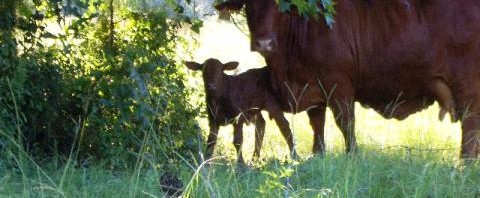Custom Grass-fed Beef Sale
We have a very limited number of spots on a batch of grass-fed beef going in for processing around July 3. Read on for details on how to fill your freezer with fresh beef cut just for you!
Our beef is 100% grass-fed and grass-finished, and is fat, marbled, and excellent quality. No tubs, no cubes, no grains, no licks–just rotational grazing, good breeding, good minerals, and plenty of finishing time!
Grass-fed Beef by the Half
Halves are expected to hang at 250-325 pounds. Take-home poundage (excluding fat/organs) expected to be about 160-220 pounds. Including processing cost, this translates to between 8.5% and 13% savings over retail prices, depending on whether you opt for a half or whole. That’s a final savings amount of at least $135 and as much as $280 on a larger whole!
Price is $4.50/lb hanging for a half (does not include processing).
Processing typically runs about $1.23/lb before extra charges (for sausage, etc).
Payments are to be made in 3 parts:
- Deposit to reserve is $300, paid online prior to June 24. Space is limited–first come, first served!
- Balance to be paid via mailed check after hanging weight is determined. (To pay online, add 3% convenience fee.)
- Processing to be paid via phone directly to processor prior to pickup (Panola County Processing)—ready in mid- to late-July.
Pickup can be either at the butcher in Carthage, at the ranch in Jefferson, or via our next drop point of your choice in Tyler, Longview, Marshall, or Shreveport after beef is picked up from butcher. We will work with you on this once an exact pickup date is known.
Save even more if you want the whole animal! Only $4.20/lb (plus processing) for a whole. Get with friends to reserve a whole cow! You can expect to save an additional $150 or more compared with a half. Be sure to purchase 2 deposits to hold both “sides.”
What to Expect
This batch of steers is young and fat and will make excellent beef. Your price is based on the carcass or “hanging” weight of the animal after the entrails, hide, and hooves/head are removed. The carcass is then aged to improve flavor and tenderness, and will shrink a bit during this time due to moisture loss. Then, when surplus fat and edges are cut away and various muscles are deboned, the yield is reduced to an approximate 66% of the hanging weight, depending on your cutting preferences. So if your side hung at 250 pounds, you can expect to get approximately 66% of that back as “cuts,” or a final take-home yield of 165 pounds.
We’ll walk you through the cutting process to help you get exactly what you’ll love, and we can make recommendations specific to our animals that will ensure your satisfaction.
Here’s a very rough breakdown of what you will receive with typical cutting:
- Steaks (Strip, Filet, Ribeye, Sirloin, Fajita): 15% of cuts yield
- Roasts (Chuck, Arm, Shank, Round, Rump): 30% of cuts yield (but highly customizable)
- Burger, Round Steak, Stew Meat: 40% of cuts yield (highly customizable)
- Other cuts (Ribs, Brisket): 10% of cuts yield
- Liver, Organs, Bones: 5% of cuts yield
**These numbers are estimates only and will vary based on the anatomy of your animal and on your cutting requests.
How Much Freezer Space Will It Take?
We find that planning for 1 cubic foot per 25 pounds of meat works well to be able to navigate your freezer inventory reasonably easily. According to this estimate, you will need at least 7 cubic feet to store a typical half beef, or 1 mid-size home chest freezer (empty). But in case the animals run a little larger, it never hurts to plan for extra freezer space! Be sure to check your freezer regularly to make sure it’s working.
How to Get Started
Ready to sign up for your half of beef? Hop over to our online reservation site: https://squareup.com/store/shady-grove-ranch/
After you place your deposit, we’ll get in touch to complete your cutting orders. Thanks for supporting our work!
Place a Beef Deposit








